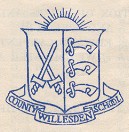| Walking to school
included several important stop-offs on the way in those days. There
was the abattoir in Crown Yard at the back of Milton Hearsant's butchers
shop and, just along from there, right on Jubilee Clock corner, the
blacksmiths, where the farrier would shoe horses. There was a large
horse-trough just past there towards Acton lane. At Craven Park or
at the Clock Tower there was almost always a tram (and later a
trolley-bus) with its arms off the wire. Sometimes a tram took the
bend at the "Royal Oak" too fast with the same result. When the
Anti-vivisection League took over a shop at the bottom of Park Parade they
caused a bit of a sensation with their display of pictures.
Haycroft Farm (United Dairies) was out
of bounds but the short-cut round the back to the stables was such an
attraction that the risk of getting caught was never considered. On
the way home, the field, where Cardinal Hindsley School now stands was
another attraction. The Post office tug-of-war team used to practise
there. They had an ingenious shear-legs of three telegraph poles
rigged up to a large cistern full of rocks and they would tug away for
hours, frequently with a County School audience. Later in 1938/39,
on the opposite ground where "The Hub" was eventually built, there were
demonstrations of how to erect an Anderson shelter, put out an incendiary
bomb, operate a stirrup pump and put on a gas mask. All these skills
came into use shortly after.
I suppose the most enduring memory of
schooldays was the contrast in punishment systems between Stonebridge
Junior and Willesden County. At Stonebridge all teachers implemented
corporal punishment in varying ways. These ranged from a size 14
plimsoll, a yardstick, a knotted rope and the "fairy wand" - a frayed cane
with a choice of ends which raised black wheals across a hand.
At Willesden the range was lines
and/or detention. The most unforgettable was the day I was sent to
Mr. Wallis by Mr. P.J. Smith, the maths master for an unappreciated
wisecrack. Mr. Southam, encountered on the way, heard the whole
story and said "On you go then". I recited the story to the
secretary (Was it Miss Ives?), who told me to wait. Mr. Wallis
eventually emerged, heard the recital and said "Come back at break".
This reception was repeated by both of them at break, lunch and at the end
of school, where, at the seventh account of my crime Mr. Wallis said "Off
you go Hargreaves". And that was that; no boasting to my friends, no
feelings of being brave; just a sixty year memory of my humiliation.
I never did it again. Edward
A. Hargreaves |
